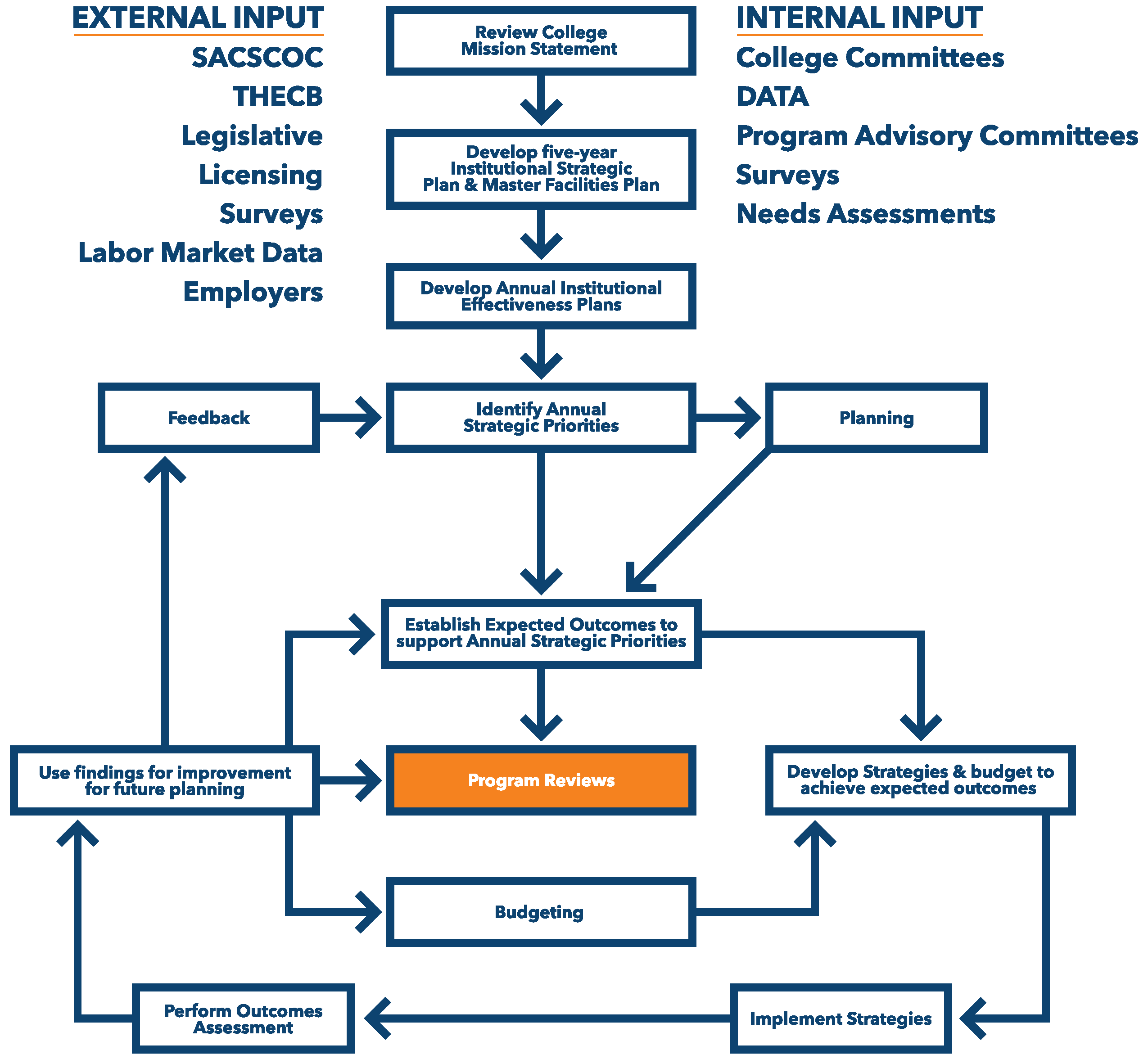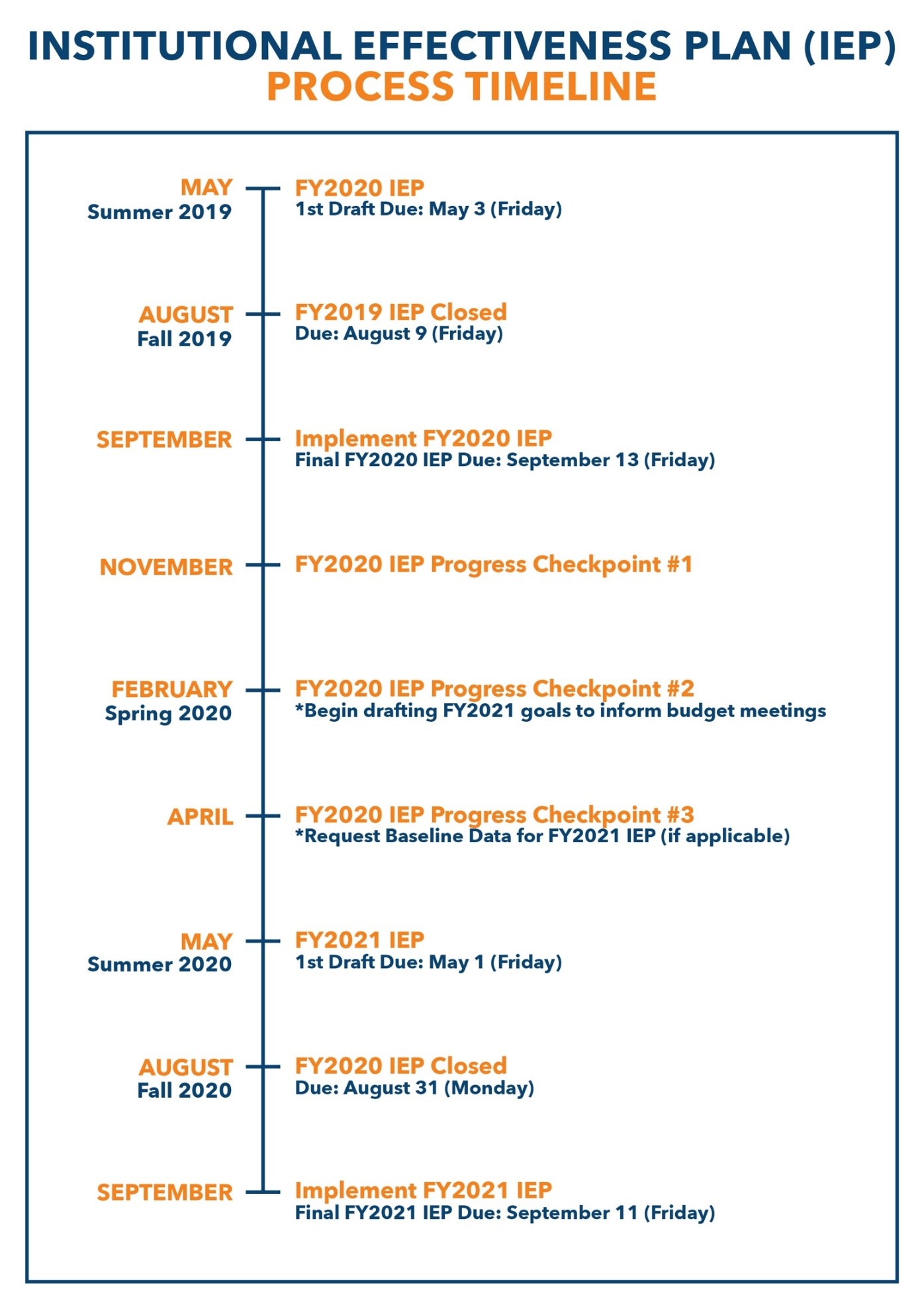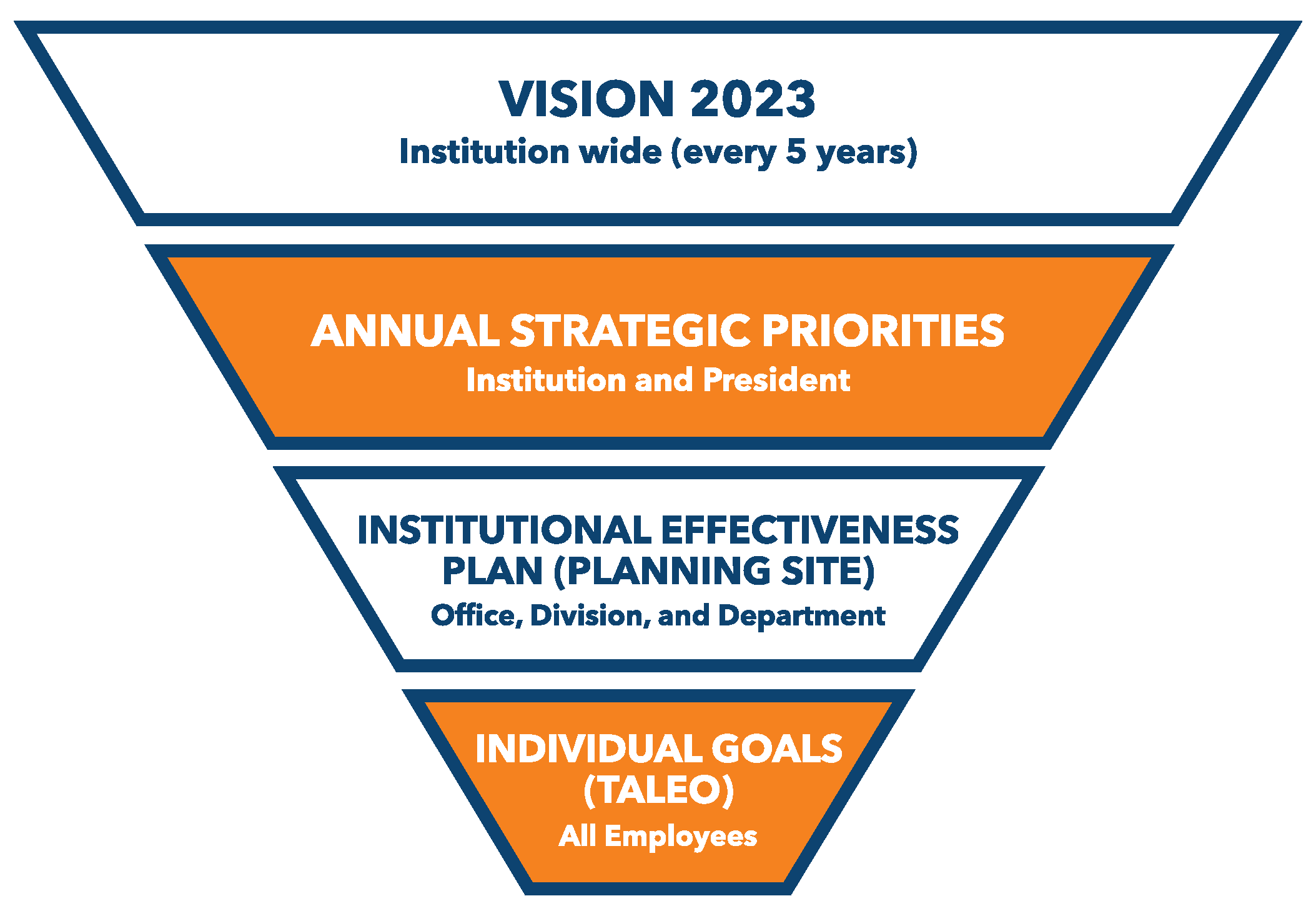Institutional Effectiveness |
|
Texas Southmost College (TSC) engages in a continuous quality improvement process. The institution’s institutional effectiveness process integrates institution-wide researched-based planning and evaluation activities, which incorporates a review of programs and services, resulting in continuing improvement and demonstrating that the institution is effectively accomplishing its mission. TSC Institutional Effectiveness Process TSC's Institutional Effectiveness Process consists of the following key components a) Strategic planning and b) Operational planning. An evaluation component is included within each of these key activities. TSC’s Institutional Effectiveness (IE) Cycle is on a 5-year cycle. The diagram below identifies the components of the IE cycle which informs the strategic and operational planning of the institution. (See Figure 1.1)
Strategic Planning At Texas Southmost College, strategic planning is a dynamic, collaborative, and continuous process that sets the future direction for the college, and ensures the long-term viability of our institution for our students and community. a.) Strategic planning allows the institution to develop a long-term direction and focus. As a result, this process serves as the framework for continuous planning at TSC. This allows for the development of objectives by the president, derived from the institutional goals identified in the five-year Strategic Plan. In summary, strategic planning serves to identify the intended purpose, direction, and expected outcomes of the College. The institutional effectiveness process at TSC begins with the mission statement and strategic plan, which provides the focus and scope of the college's activities. Texas Southmost College (TSC) is an institution of higher education that is still emerging from two decades of operation under The University of Texas at Brownsville. Now under the leadership of new TSC President, Jesús Roberto Rodríguez Ph.D., and with a Board of Trustees in place that has an interest in planning for the future, TSC embarked in a 7 month long strategic planning process. In fall 2017, TSC identified and contracted a consultant to expedite the extensive strategic planning process. The process of developing a strategic plan embraced transparency and sought to build consensus by including feedback from faculty, administration, staff, students, alumni and community leaders. TSC’s strategic planning was launched in October 2017 with a workshop for the college’s Board of Trustees. A framework for constituent conversations was presented and guiding questions were prepared for a series of focus sessions. All-inclusive sessions were held for students, faculty, staff, administrators, alumni, and community leaders. These focus group sessions were held on November 14, 2017 with faculty, administrators, staff, students, alumni and community leaders. As a result of those focus sessions, reports were generated by the consultant. The results of the discussions were presented at a college-wide event on January 8, 2018 which included information about the service region, workforce issues, current and prospective students. Vision 2023 is the outcome of those collaborative sessions and it will serve as the guide for the work that will impact how the Institution plans and budgets for the next five- year period. Vision 2023 outlines 5 Strategic Goals which encompasses 43 Strategic Priorities. On May 16th, the new 5-year strategic plan, Vision 2023, was approved unanimously by the Board of Trustees as the College's second strategic plan. As a result, Vision 2023 now serves as the foundation for TSC's allocation of resources for activities, programs, and personnel. As part of the strategic plan, TSC maintained its unique Vision Statement, Mission Statement, Role and Scope, and Values that will continue to serve as a guide for the institution over the next five years. The TSC Strategic Plan, Vision 2023 is designed to define and support how TSC accomplishes its mission. This new Plan consists of five distinct institutional goals and their corresponding strategic directions. The five primary goals of TSC’s Vision 2023 Strategic Plan include:
Operational Planning Linked to the College’s Strategic Plan and Annual Strategic Priorities, operational planning allows for broad-based involvement and participation by faculty and staff. All plans and evaluation reports are reviewed by the department chairs, deans or vice presidents, and finally brought to and approved by the president. b.) Operational planning allows for focused review of educational, administrative, and support programs and services, based on the College’s goals, objectives and expected outcomes. Individuals at the implementation level are responsible for developing different but complementary plans of action for service and improvement:
Institutional Research to Inform Planning Planning and improvement decisions are the result of the analysis of both outcome metrics and feedback provided by students and other institutional constituents. The Texas Higher Education Coordinating Board (THECB) requires the submission of record level student, faculty, and courses at the beginning and then at the end of each institutional semester. The THECB uses student record level data to track student progress, movement between institutions, and post-graduation outcomes. Student satisfaction is monitored through a collection of student feedback mechanisms in the form of surveys, evaluations of faculty, focus groups, as well as other less formal mechanisms. Recurring studies providing student feedback of their satisfaction, attitudes and values are captured through the administration and collection of the following:
Student progress is also tracked using internally produced data like course grade distributions that help faculty and administrators identify trends in high failure rate courses throughout the curriculum so that interventions and improvements can be implemented in an effort to boost student levels of success. The State of Texas publishes institutional information on the website for the THECB. In addition, the reports submitted by TSC are audited by the state. The data that is submitted to the THECB is aggregated and tracked over time, providing rich sources of data to determine where strengths and weaknesses in both student and institutional performance lie. THECB data that informs strategic and operational planning includes:
The resources above that provide data for analysis and consideration help to inform decisions regarding where efforts and attention should be focused with regards to students and their success, as well as the efficiencies of the institution. How is Vision 2023 connected to every employee? Every year, TSC’s Board of Trustees will identify the Annual Strategic Priorities that will be used to assess the President’s and the Planning Units effectiveness. All planning units must have at least one goal from the Annual Strategic Priorities in their IEP. Every individual that works at TSC must complete an annual performance review. Their individual goals must be aligned to their planning unit (i.e. Division, Office, Department) goals which will be outlined in the IEP. The funnel below reflects how individual employee action and goal attainment is directly linked to TSC’s strategic plan, Vision 2023. (See Figure 3.1)
|
| Last Updated on Tuesday, 21 January 2020 09:05 |






